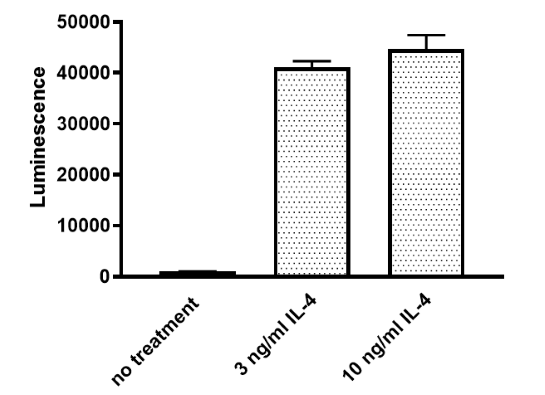78799
STAT6 Luciferase Reporter Lentivirus (STAT6 Signaling Pathway)
BPS Bioscience
DESCRIPTION
The STAT6 Luciferase Reporter Lentiviruses are replication incompetent, HIV-based, VSV-G pseudotyped lentiviral particles that are ready to transduce most mammalian cells, including primary and non-dividing cells. These viruses contain a firefly luciferase reporter driven by multiple copies of STAT6 (signal transducer and activator of transcription 6) responsive elements located upstream of the minimal TATA promoter. The lentiviruses also contain a puromycin selection marker. After transduction, the cellular STAT6 signaling pathway can be monitored by measuring the luciferase activity.
DETAILS
- Notes: To generate a STAT6 luciferase reporter stable cell line, remove the growth medium 48 hours after transduction and replace it with fresh growth medium containing the appropriate amount of puromycin (as pre-determined from a killing curve, FAQs (bpsbioscience.com) for antibiotic selection of transduced cells, followed by clonal selection. The following Lentivirus Reporter Controls are available from BPS Bioscience to meet your experimental needs: Negative Control Luciferase Lentivirus (BPS Bioscience #79578): Ready-to-transduce lentiviral particles expressing firefly luciferase under the control of a minimal promoter. This negative control is important to establish the specificity of any treatments and to determine the background reporter activity. Renilla Luciferase Lentivirus (BPS Bioscience #79565): Ready-to-transduce lentiviral particles expressing Renilla luciferase under the control of a CMV promoter. The Renilla luciferase lentiviruses can serve as an internal control to overcome sample-to-sample variability when performing dual-luciferase reporter assays. Firefly Luciferase Lentivirus (BPS Bioscience #79692-G, #79692-H, #79692-P): Ready-to-transduce lentiviral particles expressing firefly luciferase under the control of a CMV promoter. It serves as a positive control for transduction optimization studies. Biosafety: The lentiviruses are produced with SIN (self-inactivation) lentivector which ensures self-inactivation of the lentiviral construct after transduction and integration into the genomic DNA of the target cells. None of the HIV genes (gag, pol, rev) will be expressed in the transduced cells, as they are expressed from packaging plasmids lacking the packing signal and are not present in the lentivirus particle. Although the pseudotyped lentiviruses are replication-incompetent, they require the use of a Biosafety Level 2 facility. BPS Bioscience recommends following all local federal, state, and institutional regulations and using all appropriate safety precautions. Troubleshooting Guide: Visit bpsbioscience.com/lentivirus-faq for detailed troubleshooting instructions. For all further questions, please email support@bpsbioscience.com.
- Shiptemp: -80°C (dry ice)
- Warnings: Avoid freeze/thaw cycles
- Category: Cell Signaling/Lentivirus
- Background: STAT6 (signal transducer and activator of transcription 6) is a member of the STAT family of proteins which activate gene expression by relaying signals from cytokines that bind to their receptors on the cell surface to the nucleus. STAT6 is mainly activated by IL-4 (interleukin-4) and IL-13, via phosphorylation by JAKs (Janus kinases). Once phosphorylated, STAT6 forms a homodimer that translocate to the nucleus and binds to DNA via the DNA-binding domain, activating gene transcription. STAT6 signaling is involved in T-helper type 2 (Th2) cell development and differentiation, macrophage activation, and it impacts the levels of CD20 on the surface of B lymphocytes. Gene fusions products of STAT6 with NGFI-A-binding protein 2 (NAB2) are responsible for fibrous tumors. Dysfunction of the STAT6 pathway leads to allergic reactions (asthma, atopic dermatitis, food allergies) and cancer (Hodgkin, central nervous system and follicular lymphoma). STAT6 can serve as a diagnostic and prognostic tool. Inhibitors have been shown to reduce acute inflammation in animal models, and future developments may lead to new therapeutical tools for STAT6 related pathologies.
- References: Kim M., et al., 2018 Cell Physiol Biochem 45(5):1863-1877. Hu X.,et al., 2021Signal Transduction and Targeted Therapy 6: 402. Karpathiou G.,et al., 2021Pathol Res Pract. 223:153477.
- Description: The STAT6 Luciferase Reporter Lentiviruses are replication incompetent, HIV-based, VSV-G pseudotyped lentiviral particles that are ready to transduce most mammalian cells, including primary and non-dividing cells. These viruses contain a firefly luciferase reporter driven by multiple copies of STAT6 (signal transducer and activator of transcription 6) responsive elements located upstream of the minimal TATA promoter. The lentiviruses also contain a puromycin selection marker. After transduction, the cellular STAT6 signaling pathway can be monitored by measuring the luciferase activity.
- Formulation: The lentivirus particles were produced from HEK293T cells. They are supplied in cell culture medium containing 90% DMEM + 10% FBS. Virus particles can be packaged in custom formulations by special request, for an additional fee.
- Supplied As: Two vials (500 µl x 2) of lentivirus at a titer >107 TU/ml. The titer will vary with each lot; the exact value is provided with each shipment.
- Unspsc Code: 41106621
- Unspsc Name: Virus mediated expression vectors or kits
- Applications: Screen for activators or inhibitors of the STAT6 signaling Generate STAT6 Luciferase Reporter cell pools or stable cell lines by puromycin selection.
- Product Type: Lentivirus
- Biosafety Level: BSL-2
- Related Products: 79578, 79565, 79692
- Storage Stability: Lentiviruses are shipped with dry ice. For long-term storage, it is recommended to store the lentiviruses at -80°C. Avoid repeated freeze/thaw cycles. Titers can drop significantly with each freeze/thaw cycle.
- Scientific Category: Cell Signaling Pathway

